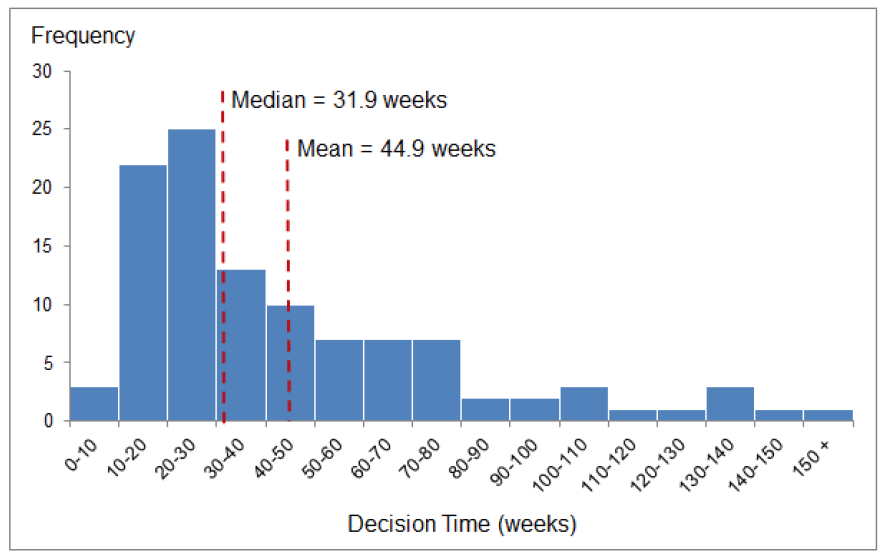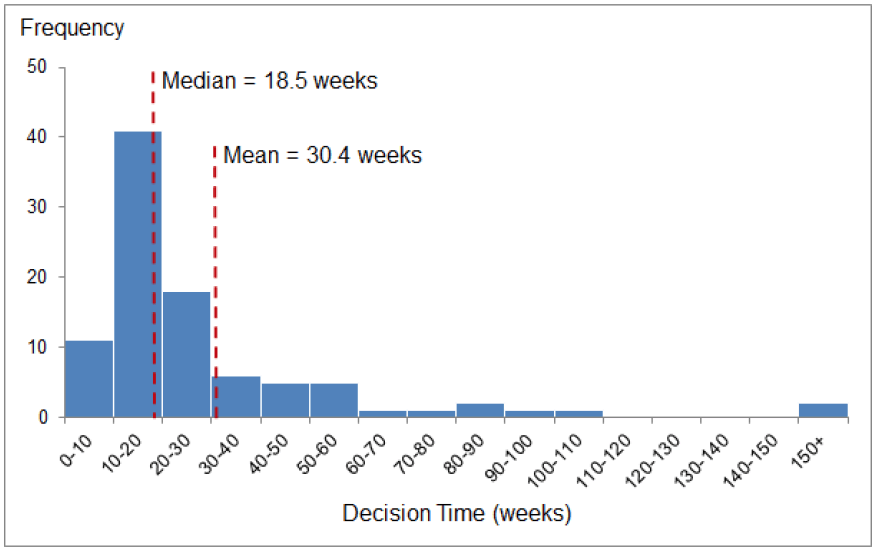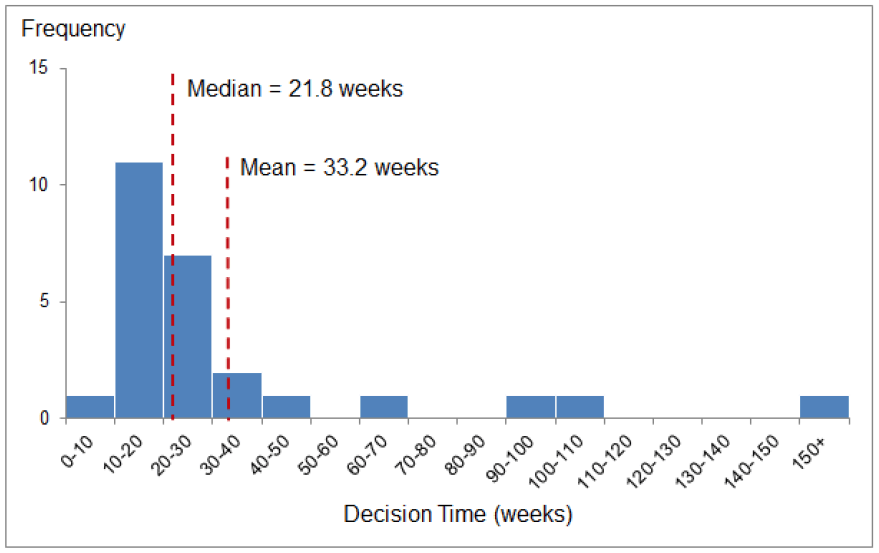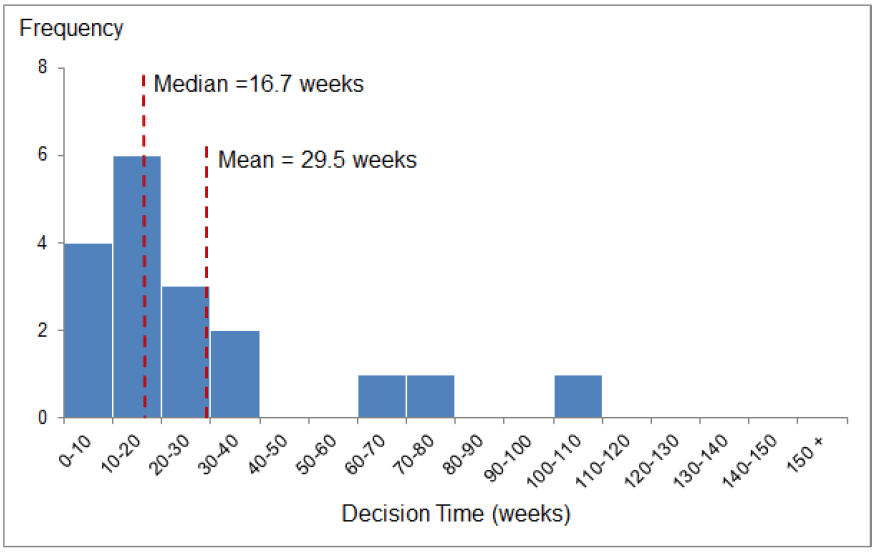Planning performance statistics: annual and quarterly reports, 2016-2017
Statistics on planning decision-making and timescales between the periods 2012 to 2013 and 2016 to 2017.
14. Annex
14.1 Stopping the Clock
In some cases it is appropriate to remove a length of time from the total decision time. We have called this process of removing a specific length of time "stopping the clock". This should not be used for every application; it is about recording the data in a way that produces more accurate and relevant performance statistics that would otherwise have been skewed by extreme cases of delay outwith the planning authority's control. For the year 2016/17 there were a total of 1,170 applications where the clock was stopped for an average of 21.4 weeks. This compares with 1,402 applications stopped for an average of 30.8 weeks in the previous year. The table below shows the number of applications where the clock has been stopped by planning authority.
Table 9: Clock stops by planning authority, 2016/17 1,2
| Planning Authority | Total applications decided in 2016/17 | Number of applications with clock stopped | Percentage of applications with clock stopped | Average length of time clock stopped (weeks) |
|---|---|---|---|---|
| Aberdeen City | 1,162 | 139 | 12.0% | 15.1 |
| Aberdeenshire | 2,153 | 50 | 2.3% | 5.4 |
| Angus | 773 | 11 | 1.4% | 30.1 |
| Argyll & Bute | 1,311 | 56 | 4.3% | 34.1 |
| Cairngorms NP | 2 | 1 | 50.0% | 23.7 |
| Clackmannanshire | 237 | 5 | 2.1% | 4.8 |
| Dumfries & Galloway | 1,106 | 10 | 0.9% | 52.5 |
| Dundee City | 610 | 43 | 7.0% | 13.4 |
| East Ayrshire | 643 | 84 | 13.1% | 30.4 |
| East Dunbartonshire | 720 | 58 | 8.1% | 6.4 |
| East Lothian | 970 | 11 | 1.1% | 53.3 |
| East Renfrewshire | 685 | 12 | 1.8% | 23.5 |
| Edinburgh, City of | 3,405 | 14 | 0.4% | 84.6 |
| Falkirk | 612 | 17 | 2.8% | 28.4 |
| Fife | 2,548 | 4 | 0.2% | 20.3 |
| Glasgow City | 2,724 | 130 | 4.8% | 22.4 |
| Highland | 2,754 | 15 | 0.5% | 78.8 |
| Inverclyde | 388 | 23 | 5.9% | 14.5 |
| Loch Lomond & Trossachs NP | 317 | 12 | 3.8% | 22.0 |
| Midlothian | 493 | 25 | 5.1% | 46.2 |
| Moray | 687 | 37 | 5.4% | 7.2 |
| Na h-Eileanan Siar | 424 | 3 | 0.7% | 14.3 |
| North Ayrshire | 631 | 9 | 1.4% | 8.6 |
| North Lanarkshire | 1,054 | 38 | 3.6% | 21.9 |
| Orkney Islands | 488 | 50 | 10.2% | 12.7 |
| Perth & Kinross | 1,672 | 72 | 4.3% | 26.0 |
| Renfrewshire | 697 | 24 | 3.4% | 11.9 |
| Scottish Borders | 812 | 2 | 0.2% | 185.6 |
| Shetland Islands | 367 | 33 | 9.0% | 12.6 |
| South Ayrshire | 856 | 3 | 0.4% | 22.2 |
| South Lanarkshire | 1,683 | 51 | 3.0% | 16.5 |
| Stirling | 790 | 1 | 0.1% | 78.3 |
| West Dunbartonshire | 246 | 50 | 20.3% | 11.6 |
| West Lothian | 724 | 77 | 10.6% | 19.5 |
| SCOTLAND | 34,744 | 1,170 | 3.4% | 21.4 |
The following table gives an analysis of applications where the clock has been stopped by development type.
Table 10: Clock stops by development type, 2016/17
| Development Type | Total applications decided in 2016/17 | Number of applications with clock stopped | Percentage of applications with clock stopped | Average length of time clock stopped (weeks) |
|---|---|---|---|---|
| Local developments | ||||
| Householder | 13,400 | 172 | 1.3% | 7.7 |
| Other developments | 5,920 | 226 | 3.8% | 19.9 |
| Housing | 4,901 | 381 | 7.8% | 22.7 |
| Business and Industry | 1,738 | 102 | 5.9% | 12.9 |
| Telecommunications | 457 | 8 | 1.8% | 11.3 |
| AMSCs | 294 | 25 | 8.5% | 38.0 |
| Electricity Generation | 178 | 20 | 11.2% | 26.2 |
| Waste Management | 30 | 1 | 3.3% | 312.9 |
| Minerals | 28 | 3 | 10.7% | 27.0 |
| Marine Shellfish Farming | 26 | 3 | 11.5% | 9.8 |
| Marine Finfish Farming | 18 | 3 | 16.7% | 4.4 |
| Freshwater Fish Farming | 0 | 0 | - | - |
| TOTAL | 26,990 | 944 | 3.5% | 18.8 |
| Major developments | ||||
| Housing | 108 | 37 | 34.3% | 41.0 |
| Other Developments | 96 | 22 | 22.9% | 80.7 |
| Business and Industry | 26 | 7 | 26.9% | 44.3 |
| Electricity Generation | 10 | 4 | 40.0% | 62.6 |
| Minerals | 6 | 2 | 33.3% | 325.9 |
| Waste Management | 3 | 1 | 33.3% | 19.7 |
| Marine Shellfish Farming | 0 | 0 | - | - |
| Freshwater Fish Farming | 0 | 0 | - | - |
| Marine Finfish Farming | 0 | 0 | - | - |
| TOTAL | 249 | 73 | 29.3% | 62.0 |
| Other Consents | ||||
| Listed bldg.+con.area consents | 3,593 | 92 | 2.6% | 20.3 |
| Advertisements | 2,057 | 50 | 2.4% | 13.0 |
| Other consents and certificates | 1,828 | 5 | 0.3% | 11.2 |
| Hazardous substances consents | 14 | 5 | 35.7% | 8.5 |
| TOTAL | 7,492 | 152 | 2.0% | 17.2 |
| Local with EIA | ||||
| Local Developments Subject To EIA | 12 | 1 | 8.3% | 64.3 |
| AMSCs (Subject to EIA) | 1 | 0 | - | - |
| TOTAL | 13 | 1 | 7.7% | 64.3 |
For 2016/17, local housing developments have the most applications where the clock has been stopped, with 22.7 weeks on average removed from decision times. This represents 7.8% of all applications for local housing developments. There are a variety of reasons why the clock is stopped but are often due to delays in concluding legal agreements and waiting for the applicant to sign a planning obligation. Other reasons include site survey required in relation to European protected species that must await a particular season, external consultants delay or awaiting advert fees to be paid.
Stop the clock advice has been issued to planning authorities to help with decisions for stopping the clock and is available at;
http://www.gov.scot/Topics/Statistics/Browse/Planning/DataSupplierArea
14.2 Distribution of decision times for major applications.
Chart 64 shows the distribution of the decision times for major housing applications (post 3rd August 2009) that were concluded in 2016/17.
Chart 64: Distribution of decision times for major housing applications (post 3rd August 2009), 2016/17 (there were no legacy cases)

The vertical line at 44.9 weeks shows the mean (average) decision time for major housing developments. The second line at 31.9 weeks shows the median decision time. Decision times range from 7.4 weeks to 177.4 weeks. The chart shows that the mean decision time has been influenced by several lengthy decisions. Almost 64% of major housing applications were decided in a time quicker than the average of 44.9 weeks. Nearly 40% of major housing applications were decided within 6 months.
The three lengthiest decisions that all took 140 weeks or longer are one each in South Lanarkshire, North Lanarkshire and Midlothian. The South Lanarkshire application was for residential developments with associated landscaping, roads, neighbourhood centre, community facilities and infrastructure works (with Environmental Impact Analysis), the North Lanarkshire application was for a residential development of up to 450 units, access and associated works and the Midlothian application is described as an application for planning permission in principle for residential development with associated car parking and access. All three applications were approved.
Chart 65 shows the distribution of the decision times for major other developments (post 3rd August 2009) that were concluded in 2016/17. The category "other developments" includes any developments not falling wholly within any of the specific categories of development for minerals, housing, business & industry, waste management, electricity generation, fish farming. It includes, but is not limited to, retail, leisure and entertainment, education, healthcare, community facilities, transport interchanges, water and drainage developments and projects. It can also include mixed use projects.
Chart 65: Distribution of decision times for major other developments ( post 3rd August 2009 ), 2016/17 (excludes 2 legacy cases)

The vertical line at 30.4 weeks shows the mean (average) decision time for major other developments. The second line at 18.5 weeks shows the median decision time. Decision times range from 5.7 weeks to 284.1 weeks. The chart shows that the average decision time has been influenced by several lengthy decisions. Almost three quarters of major other developments were decided in a time quicker than the average of 30.4 weeks and 68% were decided within 6 months.
The lengthiest decision that took 284.1 weeks is in Falkirk Local Authority and is described as a development of up to 550 houses, a neighbourhood centre including retail and community uses, access junctions, new access roads, provision of a nature conservation area, associated roads and infrastructure. The application was approved.
Chart 66 shows the distribution of the decision times for major business and industry applications (post 3rd August 2009) that were concluded in 2016/17.
Chart 66: Distribution of decision times for major business and industry applications (post 3rd August 2009), 2016/17 (there were no legacy cases)

The vertical line at 33.2 weeks shows the mean (average) decision time for major business and industry developments. The second line at 21.8 weeks shows the median decision time. Decision times range from 9.1 weeks to 159.6 weeks. The average decision time has been influenced by a few lengthy decisions. Almost 77% of major business and industry applications were decided in a time quicker than the average of 33.2 weeks and more than 69% were decided within 6 months.
The lengthiest decision that took 159.6 weeks is in Aberdeenshire and is described as the change of use of land from agricultural to business, general industrial storage and distribution and formation of access. The application was approved.
Chart 67 shows the distribution of the decision times for the remaining major applications (post 3rd August 2009) that were concluded in 2016/17. These include applications for minerals, waste management and electricity generation.
Chart 67: Distribution of decision times for remaining major applications (post 3rd August 2009), 2016/17 (excludes 1 legacy case)

The vertical line at 29.5 weeks shows the mean (average) decision time for the remaining major developments. The second line at 16.7 weeks shows the median decision time. Decision times range from 5.3 weeks to 109.0 weeks. The chart shows that the average decision time has been skewed by a few lengthy decisions. Two thirds of the remaining major applications were decided in a time quicker than the average of 29.5 weeks and 61% were decided within 6 months.
The lengthiest decision that took 109.0 weeks is in Aberdeenshire and is described as continued mineral extraction and proposed extension including recycling of imported waste and site restoration. The application was approved.
14.3 Planning Performance Guidance
Detailed guidance is available to planning authorities to help with submission of quarterly data. This can be found here:
http://www.gov.scot/Topics/Statistics/Browse/Planning/DataSupplierArea
14.4 Calculation of cut-off date for 2 month target
Months are measured from a specific day in one month until the day with the preceding date in the following or subsequent months. Further guidelines on how this is calculated can be found here:
http://www.gov.scot/Topics/Statistics/Browse/Planning/DataSupplierArea
14.5 Revisions
The revisions policy for planning performance statistics has been developed in accordance with the UK Statistics Authority Code of practice for Official Statistics and further details are available at: http://www.gov.scot/Topics/Statistics/Browse/Planning/Revisions
During the analysis of annual figures for 2016/17 there have been a very small number of changes to previously published quarterly data, which have been incorporated into annual summaries.
The quarterly revisions have been footnoted in the latest publication:
Planning Authority Performance Statistics 2016/17 Quarter 4
14.6 Statistics for other UK countries
Information and statistics on planning applications for the other UK countries can be accessed at the following links:
England: https://www.gov.uk/government/collections/planning-applications-statistics
Wales: http://wales.gov.uk/topics/planning/planningstats/?lang=en
Northern Ireland: http://www.planningni.gov.uk/index/tools/about-statistics.htm
Contact
Email: planstats@gov.scot
Phone: 0300 244 4000 – Central Enquiry Unit
The Scottish Government
St Andrew's House
Regent Road
Edinburgh
EH1 3DG
There is a problem
Thanks for your feedback